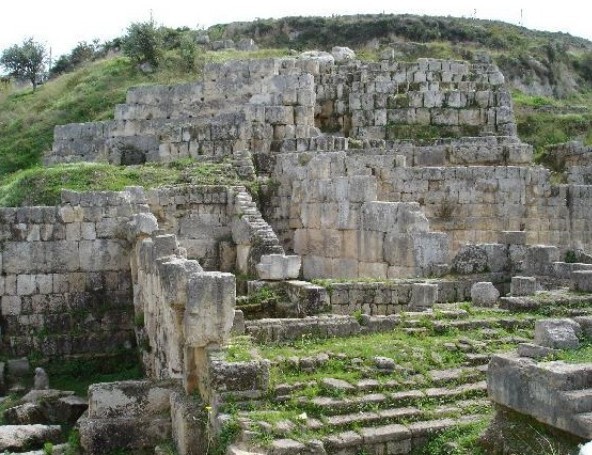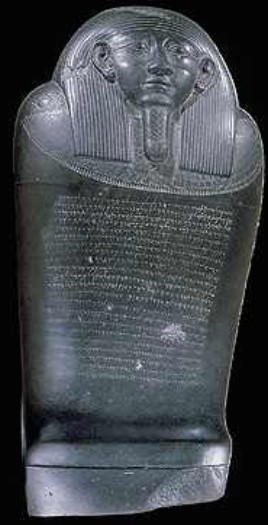Eshmun in context
Eshmun, a poliad god, was Sidon's arch-saviour and healer. The temple at Bostan eish Sheikh still boasts its foundation stones and remains the foremost Phoenician monument in Lebanon. It lies just over 1km north of modern day Sidon on the left bank of the Awali River, formerly the Bostrenus also Hellenized as Asclepius Fluvius[1]. The name of « Bostan esh Sheikh »
refers to the woodland surrounding the site which were known as the Grove of Asclepius (bustan = the grove in Arabic). The temple was built on the hillside on a podium set at the centre of the classical complex. Sidonians would have visited this pilgrimage site to be anointed with sacred oil and to immerse themselves in holy waters. Eshmun, the divine consort of goddess Astarte, was the chief god in a cult triad alongside Baal[2] and Astarte[3]. It is worth noting that there is another temple of Eshmun, inside the city of Sidon known as the “temple of Baal-Sidon”.
The unquestionably Phoenician ruins of the former temple create a first impression of complexity owed to the superimposition of constructions from several periods. The construction of the temple started towards the end of the 7th century BC. At that time, Sidon, dominated politically and culturally by Babylon held a foremost position in the Phoenician world. The temple is a pyramidal block akin to a ziggurat[4] with a water cistern; of this only a short flight of steps and a wall have survived. In the 6th century BC, the temple underwent structural enlargements. It underpinned a sanctuary that was in continuous use until the middle of the 4th century. This large masonry mass in very large blocks forms the monumental plinth on which would stand the temple, entirely built of marble.

Inscriptions found on king Eshmunazar II[5]'s anthropoid sarcophagus show that the first construction can be traced back to this king and his mother Amashtart[6]. They specify that the site was set hard by a cave in which the « Ydll »
spring surges from the mountain; by means of an ingenious system the water was piped right up to the temple and into pools intended for ritual ablutions or the immersion of the sick. Some historians maintain that it was one of the first hospitals in the world.

Some twenty inscriptions engraved on slabs testify that Bodashtart[7], king of the Sidonians, of the descent of Eshmunazar I[8] had the temple built to his God Eshmun in the 6th century BC. In fact, some ten items carry the name of king Bodashtart alone while in other inscriptions, it comes associated with the name of crown prince Yatonmilk[9]. Bodashtart built only a part of the temple's foundation block which corresponds to about one third of the great podium, the whole masonry mass further south is the work of Eshmunazar II, styled “priest of Ashtart” as were all king Eshmunazars. In the 5th century BC a monumental quadrangular ashlar podium intended to set off the temple of Eshmun was added to the sanctuary complex. Taken alone, it represents a 70x50m mass standing 22m high and echoes the temples of Achaemenid[10] Persepolis. Within the sanctuary proper stood a square based cella[11] or naos[12] topped by Achaemenid capitals in ancient Hellenistic style, the protomes of which set back to back two pairs of marble bulls representing the god Hadad[13]. In the Hellenistic era, it served as a raised altar in the temple courtyard. Eight Phoenician ostraka[14] date back to the Achaemenid period at the turn of the 6th and 5th centuries BC.

 Informations[15]
Informations[15]During the Hellenistic period, further developments were added, notably the Building with the Children Friezes set at the foot of the high podium, showing children in procession and the Shrine of Astarte with its pool, its frieze-carved wall complete with an empty throne. The Greeks sought to Hellenize the Temple of Eshmun but the sanctuary's curative functions remained. In Roman times a monumental staircase, adorned with mosaics was built, along with a cubic altar and banqueting halls. Marble colonnades lead to it. A nymphaeum[16] the floor of which showed a drunk Maenad[17] tipping the contents of her cup into a panther's mouth opened on a suite of pools with niches intended for statues of nymphs[18]. Opposite the nymphaeum, lay the ruins of a Roman villa the courtyard of which protects a mosaic representation of the four seasons. At the Western end of the sanctuary the surviving foundations of a church mark the end of a cultural tradition. These waves of monuments are a testament to the importance of that multi-secular site.






